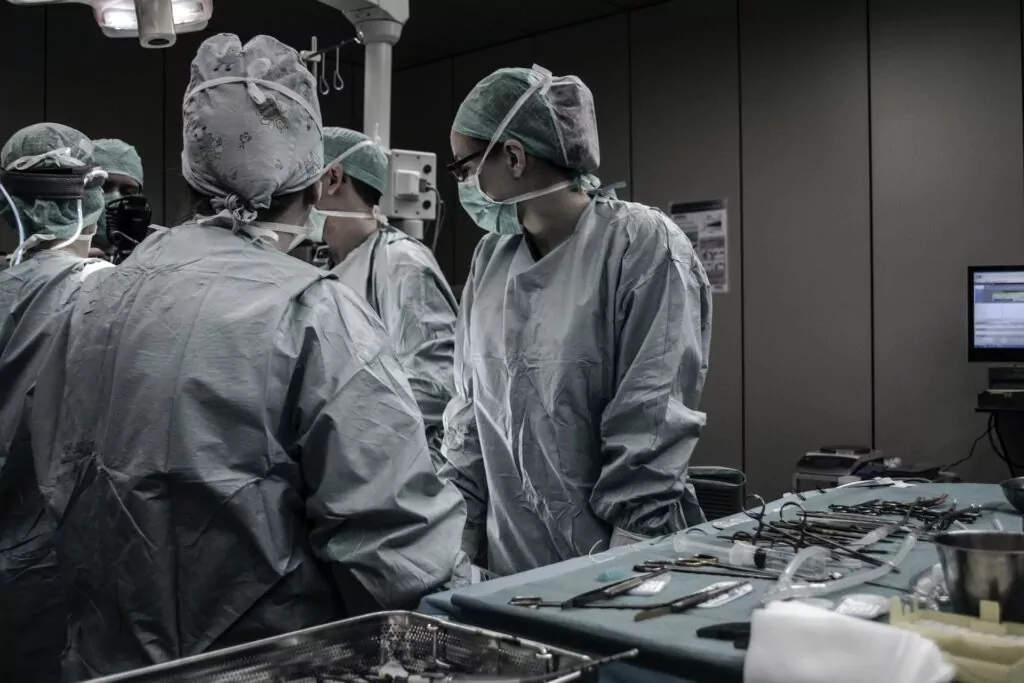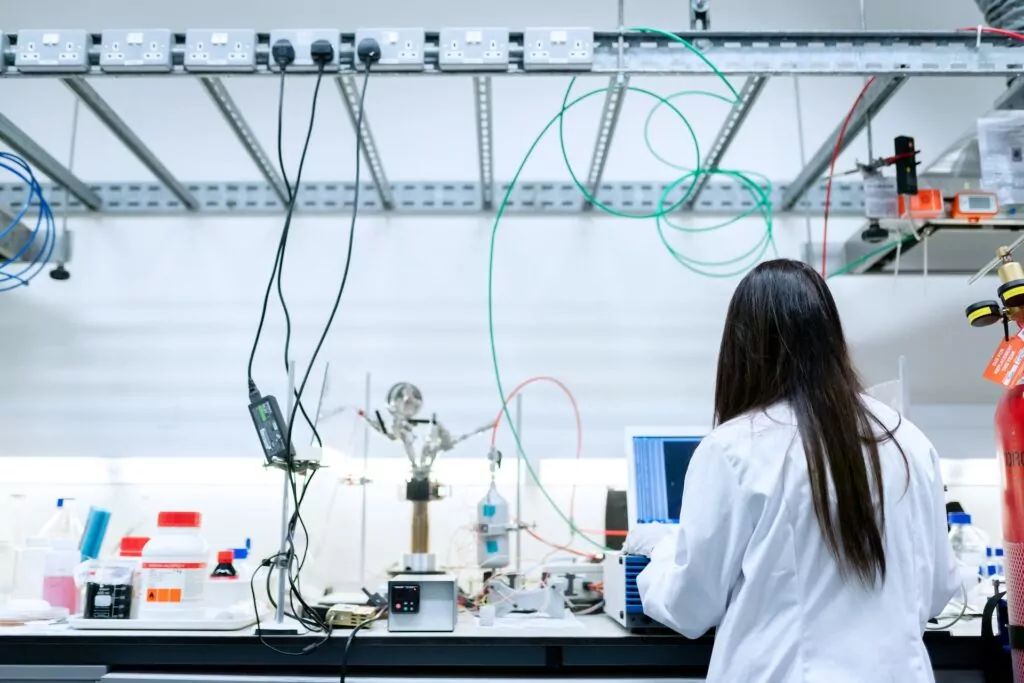Although an apple a day keeps the doctor away, we also know that without technology assisting doctors, our life quality and expectancy would be much, much lower. Luckily, nowadays, a number of diseases can be cured more smoothly than by visiting a local blacksmith or signing up for some offhand bloodletting.
The medical field is one of the finest proving grounds for future-forward solutions, and it gained that reputation over the ages not without reason. From widely used inventions, such as laser eye surgeries, in vitro, and advanced prosthetics, to novelties, e.g., telehealth, mRNA vaccines, neurotechnology, and robotics used in operating rooms and for rehabilitation – the potential for healthcare development seems endless.
Why augmented reality?
One of the novelties is the use of augmented reality in medicine. It might seem a narrow specialty at first, but when you finish reading this article, you’ll see how many use cases are already functioning – and how many more we can aim for.
In short, AR makes use of displays and cameras to overlay digital information onto the real world – for the benefit of medical professionals and patients. If you’re not familiar with the term yet, or can’t distinguish between augmented and virtual reality, go straight to the article on AR and VR.
Examples and benefits of augmented reality in healthcare
Augmented reality is not an empty buzzword in healthcare, on the contrary, it offers plenty of solutions for hospital, ambulance, and laboratory professionals. In this article, apart from depicting particular use cases, we’ll also try to answer the question: How does augmented reality benefit patients and health workers? Does it bring value unachievable with well-known and tested methods?
Augmented reality in hospitals and emergency services
Reaction time is crucial when it comes to traffic/workplace accidents, strokes, heart attacks, and other emergencies. Oftentimes it is a matter of life or death for the patients, but also greatly affects the quality of their future life. Thus, in severe cases, qualified personnel should be at the scene within seconds. Yet, with staff shortages, it isn’t always feasible.
Augmented reality can provide paramedics and nurses with the support they need by getting instructions in real-time by doctors that don’t have to be present on-site. So, without wasting time on getting to the site, they can provide aid to many more patients, solving the problem of staff shortages.
What is more, AR systems can be integrated with the equipment used in the ambulance that monitors the basic vital parameters, such as pulse, pressure, and saturation. This way, the data is sent directly to the assisting doctor, saving EMS workers time. In addition, with AR glasses, EMS workers can access patient charts in front of their eyes with their hands free, so they can continue attending to the patient.
Augmented reality in medical training
The medical field consists of not only doctors and nurses but also an array of other professions vital to keeping healthcare running: paramedics, ambulance technicians, medical assistants, therapists, pharmacists, and counselors. We can’t forget about other occupations at which medical skills are also needed. For instance water and mountain rescuers, firefighters, police officers, and non-medical health facility staff (lab technicians, office workers, and cleaners), those specialists are often first by the patient when something serious happens.
With so many parties involved, medical education has to become more accessible in the forthcoming years to cater to the growing demand for quality healthcare, especially in aging societies. AR training won’t supplant conventional medical schools, at least not anytime soon. What it is capable of, though, is allowing medical students and health professionals to gain new knowledge and skills in a more accessible and effective way. Digital courses can cover the most urgent ailments and newly introduced treatment methods and equipment so patients can benefit sooner from the care. It also applies to the areas that aren’t directly medical, such as OHS training.
It’s worth highlighting a considerable advantage of AR training even over the most attractive traditional teaching methods. With augmented reality, we can train people to perform medical procedures in a safe environment instead of learning about them by heart. In the process, the system can verify the correctness of the tasks performed. It can be achieved by using controllers simulating medical tools, as well as:
- phantoms,
- partially digital phantoms,
- or moving the whole operation to the virtual world, utilizing haptic feedback.

Augmented reality in laboratories
AR in healthcare is not reserved for the events of a direct threat to life or health. It can be successfully used in diagnostic, clinical, research, and pharmaceutical labs. On-site lab technicians can use AR workflows or remote support to conduct maintenance and recovery procedures for the most advanced equipment. Handling breakdowns without waiting for the manufacturer’s service technicians shortens unplanned downtimes and reduces repair costs. Typical malfunctions that are relatively easy to fix with AR instructions are, for example, system errors in centrifuges, broken microphones and used bulbs in NMR instruments, or damaged cables in ECG devices.

3D modeling
When planning a surgery, based on medical imaging, doctors can create a three-dimensional representation of the operated body or body part. Every patient is different; thus, the tiniest details matter – especially in endoscopic spine surgeries and microvascular operations of the brain or blood vessels. Thanks to augmented reality, surgeons can test drive the procedure. Having a virtual 3D patient, they can, for instance, simulate endoscope vision and prepare the best trajectory beforehand.
Also, AR allows for remote consultants’ presence during the exact procedure. They can manipulate and annotate elements on 3D models and verbally comment on the course of the operation (audio and video connection). To benefit from 3D modeling fully, they can also add intraoperative equipment navigation to the model.
AR assisting hospitalized patients
Apparently, some of the patients tend to have major problems navigating large hospitals. The elderly, in particular, might have difficulty finding a way back from, for example, the bathroom, and even their visiting relatives often struggle to locate the right hospital ward and room. Here, AR-based navigation systems come to the rescue. Based on place recognition and markers located in the rooms, they provide patients with directions on how to reach their destination. Add to that real-time patient tracking and nurses can quickly find a lost person.
Augmented reality apps for healthcare
The already existing apps are the best proof that AR for healthcare isn’t just a pipe dream. Here are some of the examples:
- surgery apps that provide a virtual 3D reconstruction of real organs for surgeons to, e.g., locate blood vessels or align incision points,
- diagnostic apps showing nurses and doctors where veins are situated, making it easier for them to find for the first time,
- apps assisting nurses, doctors, and surgeons with easily searchable patient information and data, displayed in front of their eyes,
- training apps, such as surgical simulators and learning management systems,
- apps for patients, e.g., showing the nearest defibrillators in public spaces, guiding mothers with breastfeeding, assisting those experiencing post-traumatic stress disorder (PTSD) and other mental health issues, and educating patients on their surgical procedures.

A vicious circle of medical training
We’d like to get back to education, which plays a major role in the quality of medical services provided, as a firsthand experience is crucial in doctors’ education. In the process, they observe operations, and when they’re ready, they can assist. However, for the benefit of patients and to avoid the unnecessary risk, doctors cannot get prepared for challenging and rare procedures.
And that’s where a dangerous part begins. When the hospital is lacking experienced doctors, they have to allow less experienced ones to take the risk. The problem is the novice doctors are acquainted with the theory but have never before assisted in the actual operation. So they take the risk, and after a time, they become experts, and the vicious circle begins.
The problem could have been solved with AR solution, the way it works in pilot flight simulator training. Then, doctors could test-drive medical procedures and make mistakes with no patient risk involved before they get a chance to attend actual patients.
The future of augmented reality in healthcare
All applications mentioned above based on augmented reality in the medical field depend heavily on non-technological advancement and legal approval based on specific regulations different for each country. And when it comes to patients’ health, lawmakers tend to be particularly reluctant toward innovations. However, we can expect that the increasing shortage of health professionals and the growing demand for treatment will make them gradually change their minds and allow for digitally enhanced medical care. The potential of augmented medical reality has yet to be fully realized and we believe it will reshape healthcare as we know it.



